The Optimized Synthesis of Barium Sulfate: A Scalable and Sustainable Laboratory Approach Using D-Optimal Design
Abstract
1. Introduction
2. Materials and Methods
2.1. Production of Barium Sulfate
2.2. Experimental Design
3. Results and Discussion
3.1. Numerical Experimental Results
3.1.1. Mass of Barium Sulfate
3.1.2. Density of Barium Sulfate
3.2. Optimization Conditions
4. Conclusions
Author Contributions
Funding
Data Availability Statement
Conflicts of Interest
References
- Dye, W.M.; Mullen, G.A.; Gusler, W.J. Field-Proven Technology To Manage Dynamic Barite Sag. In Proceedings of the IADC/SPE Drilling Conference, Miami, FL, USA, 21–23 February 2006. [Google Scholar] [CrossRef]
- Al Jaberi, J.; Bageri, B.; Elkatatny, S.; Patil, S. Primary Investigation of Barite-Weighted Water-Based Drilling Fluid Properties. ACS Omega 2023, 8, 2155–2163. [Google Scholar] [CrossRef]
- Deville, J.P. Drilling fluids. In Fluid Chemistry, Drilling and Completion; Elsevier: Amsterdam, The Netherlands, 2022; pp. 115–185. [Google Scholar]
- Bruton, J.R.; Bacho, J.; Newcaster, J. The Future of Drilling-Grade Barite Weight Material—A Case for a Substitute Specification. In Proceedings of the SPE Annual Technical Conference and Exhibition, San Antonio, TX, USA, 24–27 September 2006; pp. SPE-103135-MS. [Google Scholar]
- Afolayan, D.O. Assessment of Beneficiation Process of a Nigerian Barite Source for Utilization as Oil Drilling Mud. Ph.D. Thesis, African University of Science and Technology, Abuja, Nigeria, 2017. [Google Scholar]
- Matos, C.T.; Devauze, C.; Planchon, M.; Ewers, B.; Auberger, A.; Dittrich, M.; Wittmer, D.; Latunussa, C.; Eynard, U.; Mathieux, F. Material System Analysis of Nine Raw Materials: Barytes, Bismuth, Hafnium, Helium, Natural Rubber, Phosphorus, Scandium, Tantalum and Vanadium; Publications Office of the European Union Luxembourg: Luxembourg, 2021. [Google Scholar]
- Sun, S.; Ding, H.; Zhou, H. Preparation of TiO2-coated barite composite pigments by the hydrophobic aggregation method and their structure and properties. Sci. Rep. 2017, 7, 10083. [Google Scholar] [CrossRef]
- Bahadori, A.; Zahedi, G.; Zendehboudi, S. Estimation of potential barium sulfate (barite) precipitation in oilfield brines using a simple predictive tool. Environ. Prog. Sustain. Energy 2012, 32, 860–865. [Google Scholar] [CrossRef]
- Al-Rubaii, M.; Al-Shargabi, M.; Al-Shehri, D. A Novel Model for the Real-Time Evaluation of Hole-Cleaning Conditions with Case Studies. Energies 2023, 16, 4934. [Google Scholar] [CrossRef]
- Aremu, M.; Arinkoola, A.; Salam, K.; Ogunmola, E. Potential of local pH control additives for corrosion inhibition in water base drilling fluids. Pet. Coal 2017, 59, 611–619. [Google Scholar]
- Elkatatny, S. Mitigation of barite sagging during the drilling of high-pressure high-temperature wells using an invert emulsion drilling fluid. Powder Technol. 2019, 352, 325–330. [Google Scholar] [CrossRef]
- Maile, F.J. Colorants in coatings. Phys. Sci. Rev. 2021, 6, 707–789. [Google Scholar] [CrossRef]
- Gysau, D. Fillers for Paints; Vincentz Network: Hannover, Germany, 2017. [Google Scholar]
- Abel, A. Pigments for paint. In Paint and Surface Coatings: Theory and Practice; Woodhead Publishing Cambridge: Cambridge, UK, 1999; pp. 91–165. [Google Scholar]
- Emblem, H.G.; Hargreaves, K. Preparation, Properties and Uses of Barium Compounds. Rev. Inorg. Chem. 1995, 15, 109–138. [Google Scholar] [CrossRef]
- Qi, L.; Cölfen, H.; Antonietti, M. Control of Barite Morphology by Double-Hydrophilic Block Copolymers. Chem. Mater. 2000, 12, 2392–2403. [Google Scholar] [CrossRef]
- Carretero, M.I.; Pozo, M. Clay and non-clay minerals in the pharmaceutical industry: Part I. Excipients and medical applications. Appl. Clay Sci. 2009, 46, 73–80. [Google Scholar] [CrossRef]
- El-Mezayen, A. Mineralogical and chemical studies on some minerals used in pharmaceutical industries in Egypt. Al-Azhar J. Pharm. Sci. 2014, 50, 181–190. [Google Scholar] [CrossRef][Green Version]
- Safari, M.; Harris, M.; Deglon, D. The effect of energy input on the flotation kinetics of galena in an oscillating grid flotation cell. In Proceedings of the 27th International Mineral Processing Congress (IMPC 2014), Santiago, Chile, 20–24 October 2014. [Google Scholar]
- Lopresti, M.; Palin, L.; Alberto, G.; Cantamessa, S.; Milanesio, M. Epoxy resins composites for X-ray shielding materials additivated by coated barium sulfate with improved dispersibility. Mater. Today Commun. 2021, 26, 101888. [Google Scholar] [CrossRef]
- Krejci, M.R.; Wasserman, B.; Finney, L.; McNulty, I.; Legnini, D.; Vogt, S.; Joester, D. Selectivity in biomineralization of barium and strontium. J. Struct. Biol. 2011, 176, 192–202. [Google Scholar] [CrossRef]
- Zhang, L.; Yang, Y.; Zhang, J.; Zhou, X.; Dong, H.; Zhou, Y. Barium sulfate aspiration: Severe chemical pneumonia induced by a massive reflux of contrast medium during small bowel barium enema. Forensic. Sci. Int. 2015, 253, e16–e19. [Google Scholar] [CrossRef] [PubMed]
- Kleinsasser, L.J.; Warshaw, H. Perforation of the sigmoid colon during barium enema: Report of a case with review of the literature, and experimental study of the effect of barium sulfate injected intraperitoneally. Ann. Surg. 1952, 135, 560. [Google Scholar] [CrossRef]
- Oskarsson, A. Barium. In Handbook on the Toxicology of Metals; Elsevier: Amsterdam, The Netherlands, 2022; pp. 91–100. [Google Scholar]
- Aziz, H.A.; Ghazali, M.F.; Hung, Y.-T.; Wang, L.K. Toxicity, source, and control of barium in the environment. In Handbook of Advanced Industrial and Hazardous Wastes Management; CRC Press: Boca Raton, FL, USA, 2017; pp. 463–482. [Google Scholar]
- Matta, G.; Gjyli, L.; Kumar, M.A. Inorganic Toxicity: Environment & Human Health; LAP LAMBERT Academic Publishing: Saarbrücken, Germany, 2018. [Google Scholar]
- Vanhoof, C.; Bacon, J.R.; Ellis, A.T.; Fittschen, U.E.A.; Vincze, L. 2019 atomic spectrometry update—A review of advances in X-ray fluorescence spectrometry and its special applications. J. Anal. At. Spectrom. 2019, 34, 1750–1767. [Google Scholar] [CrossRef]
- Janssens, K. X-ray based methods of analysis. In Comprehensive Analytical Chemistry; Elsevier: Amsterdam, The Netherlands, 2004; Volume 42, pp. 129–226. [Google Scholar]
- Crabb, E.; Moore, E. Metals and Life Chapter 9; RSC Publishing: Cambridge, UK, 2010. [Google Scholar]
- Reznik, R.; Troy, H. Source Assessment: Major Barium Chemicals; Environmental Protection Agency, Office of Research and Development, Industrial Environmental Research Laboratory: Research Triangle Park, NC, USA, 1978. [Google Scholar]
- Zhang, W.; Zhou, Y.; Zhu, J.; Pan, Y. New Clean process for barium sulfide preparation by barite reduction with elemental sulfur. Ind. Eng. Chem. Res. 2014, 53, 5646–5651. [Google Scholar] [CrossRef]
- Safari, M.; Hoseinian, F.S.; Deglon, D.; Filho, K.L.L.; Souza, T. Investigation of the reverse flotation of hematite in three different types of laboratory flotation cells. In Proceedings of the 29th International Mineral Processing Congress (IMPC 2018), Moscow, Russia, 17–21 September 2018; pp. 1376–1383. [Google Scholar]
- Dibello, P.M.; Manganaro, J.L.; Aguinaldo, E.R.; Mahmood, T.; Lindahl, C.B. Barium Compounds; Kirk-Othmer Encyclopedia of Chemical Technology: Hoboken, NJ, USA, 2000. [Google Scholar]
- Dorozhkin, S.V. Calcium orthophosphates and human beings: A historical perspective from the 1770s until 1940. Biomatter 2012, 2, 53–70. [Google Scholar] [CrossRef]
- Stark, A.I. Barium Sulfate Precipitation Kinetics: An Experimental and Analytical Comparison with and Without Scale Inhibitors; The University of Manchester (United Kingdom): Manchester, UK, 2005. [Google Scholar]
- Jaffe, E.B. Abstracts of the Literature on Synthesis of Apatites and Some Related Phosphates, Part I and Part II; US Department of the Interior, Geological Survey: Reston, VA, USA, 1950. [Google Scholar]
- Toner, R.K. The Determination of the Factors Affecting the Commercial Production of Barium-Chloride From Barite and Calcium-Chloride; Purdue University: West Lafayette, IN, USA, 1939. [Google Scholar]
- Shreve, R.N.; Toner, R.K. Barium Chloride from Barite and Calcium Chloride Factors Affecting Production. Ind. Eng. Chem. 1940, 32, 568–573. [Google Scholar] [CrossRef]
- Rizkalla, E.N. Kinetics of the crystallisation of barium sulphate. Effect of additives, stirring rate and barium: Sulphate ratio on the rate of precipitation. J. Chem. Soc. Faraday Trans. 1 Phys. Chem. Condens. Phases 1983, 79, 1857–1867. [Google Scholar] [CrossRef]
- Adhikari, G.; Sudborough, J.; Watson, H. The production of barium salts from barytes. J. Indian Inst. Sci. 1922, 5, 83–105. [Google Scholar]
- Abdulla, S.A.E. Barium Sulphate: Problems, Solutions and Applications; University of Surrey (United Kingdom): Surrey, UK, 2010. [Google Scholar]
- Tasbolatovna, Y.S.; Ilyich, K.A. The most important technologies of receiving barium sulfate from barite. Eur. Sci. 2020, 6, 30–34. [Google Scholar]
- Smith, T.A.; Chen, D. Green Synthesis Approaches in Industrial Mineral Processing. Miner. Eng. 2021, 169, 106956. [Google Scholar] [CrossRef]
- Hoseinian, F.S.; Safari, M.; Deglon, D. Ion flotation kinetic predictions using empirical and phenomenological models. Miner. Eng. 2024, 210, 108645. [Google Scholar] [CrossRef]
- Baloyi, N.P.; Nheta, W.; Sibanda, V.; Safari, M. Mineralogical Insights into PGM Recovery from Middle Group (1–4) Chromite Tailings. Minerals 2024, 14, 924. [Google Scholar] [CrossRef]
- Hoseinian, F.S.; Irannajad, M.; Safari, M. Effective factors and kinetics study of zinc ion removal from synthetic wastewater by ion flotation. Sep. Sci. Technol. 2016, 52, 892–902. [Google Scholar] [CrossRef]
- Lee, R.M.; Hassan, M. Barium Sulfate in Modern Radiographic Imaging: Purity Requirements and Synthesis Challenges. Mater. Chem. Phys. 2023, 302, 127680. [Google Scholar] [CrossRef]
- Taguta, J.; Safari, M.; Govender, V.; Chetty, D. Investigating the Amenability of a PGM-Bearing Ore to Coarse Particle Flotation. Minerals 2023, 13, 698. [Google Scholar] [CrossRef]
- Nazari, S.; Hoseinian, F.S.; Li, J.; Safari, M.; Khoshdast, H.; Li, J.; He, Y. Synergistic effect of grinding time and submicron (nano) bubbles on the zeta potential state of spent lithium-ion batteries: A gene expression programming approach. J. Energy Storage 2023, 70, 107942. [Google Scholar] [CrossRef]
- Hoseinian, F.S.; Rezai, B.; Safari, M. A new kinetic model for zinc ion removal from synthetic wastewater. In Proceedings of the 10th European Metallurgical Conference (EMC 2019), Düsseldorf, Germany, 23–26 June 2019; pp. 1409–1416. [Google Scholar]
- Hasanizadeh, I.; Khoshdast, H.; Safari, M.; Asgari, K.; Rahmanian, A. Influence of Carbonated Pyrolysis Oil Recycled from Scrap Tires on Metallurgical Efficiency of Coal Flotation. Minerals 2024, 14, 765. [Google Scholar] [CrossRef]
- ASTM D2330-02(2017); Standard Test Method for Density, Relative Density (Specific Gravity), or API Gravity of Light Hydrocarbons by Pressure Hydrometer. ASTM International: West Conshohocken, PA, USA, 2017.
- Safari, M.; Harris, M.; Deglon, D.; Filho, L.L.; Testa, F. The effect of energy input on flotation kinetics. Int. J. Miner. Process. 2016, 156, 108–115. [Google Scholar] [CrossRef]
- Hassanzadeh, A.; Safari, M.; Khoshdast, H.; Güner, M.K.; Hoang, D.H.; Sambrook, T.; Kowalczuk, P.B. Introducing key advantages of intensified flotation cells over conventionally used mechanical and column cells. Physicochem. Probl. Miner. Process. 2022, 58, 155101. [Google Scholar] [CrossRef]
- Carelse, C.; Manuel, M.; Chetty, D.; Taguta, J.; Safari, M.; Youlton, K. The flotation behaviour of liberated Platinum Group minerals in Platreef ore under reduced reagent conditions. Miner. Eng. 2022, 190, 107913. [Google Scholar] [CrossRef]
- Wang, X.; Bu, X.; Ni, C.; Zhou, S.; Yang, X.; Zhang, J.; Alheshibri, M.; Peng, Y.; Xie, G. Effect of scrubbing medium’s particle size on scrubbing flotation performance and mineralogical characteristics of microcrystalline graphite. Miner. Eng. 2021, 163, 106766. [Google Scholar] [CrossRef]
- Montgomery, D.C. Design and Analysis of Experiments, 9th ed.; John Wiley & Sons: Hoboken, NJ, USA, 2017. [Google Scholar]
- Khormali, A.; Ahmadi, S. Prediction of barium sulfate precipitation in dynamic tube blocking tests and its inhibition for waterflooding application using response surface methodology. J. Pet. Explor. Prod. Technol. 2023, 13, 2267–2281. [Google Scholar] [CrossRef]
- Li, D.; Li, M.; Pan, J.; Yan, Z. The deposition kinetics of barium sulfate scale: Model development. Front. Mater. 2023, 10, 1198176. [Google Scholar]
- Piotrowski, K.; Wojtas, M.; Berenjian, A. Influence of Hydrodynamic Conditions on Precipitation Kinetics of Barium Sulfate: Experimental and Modeling Approach. Processes 2022, 10, 146. [Google Scholar]
- U.S. Geological Survey. Mineral Commodity Summaries 2021; U.S. Geological Survey: Reston, VA, USA, 2021; 200p. [Google Scholar] [CrossRef]
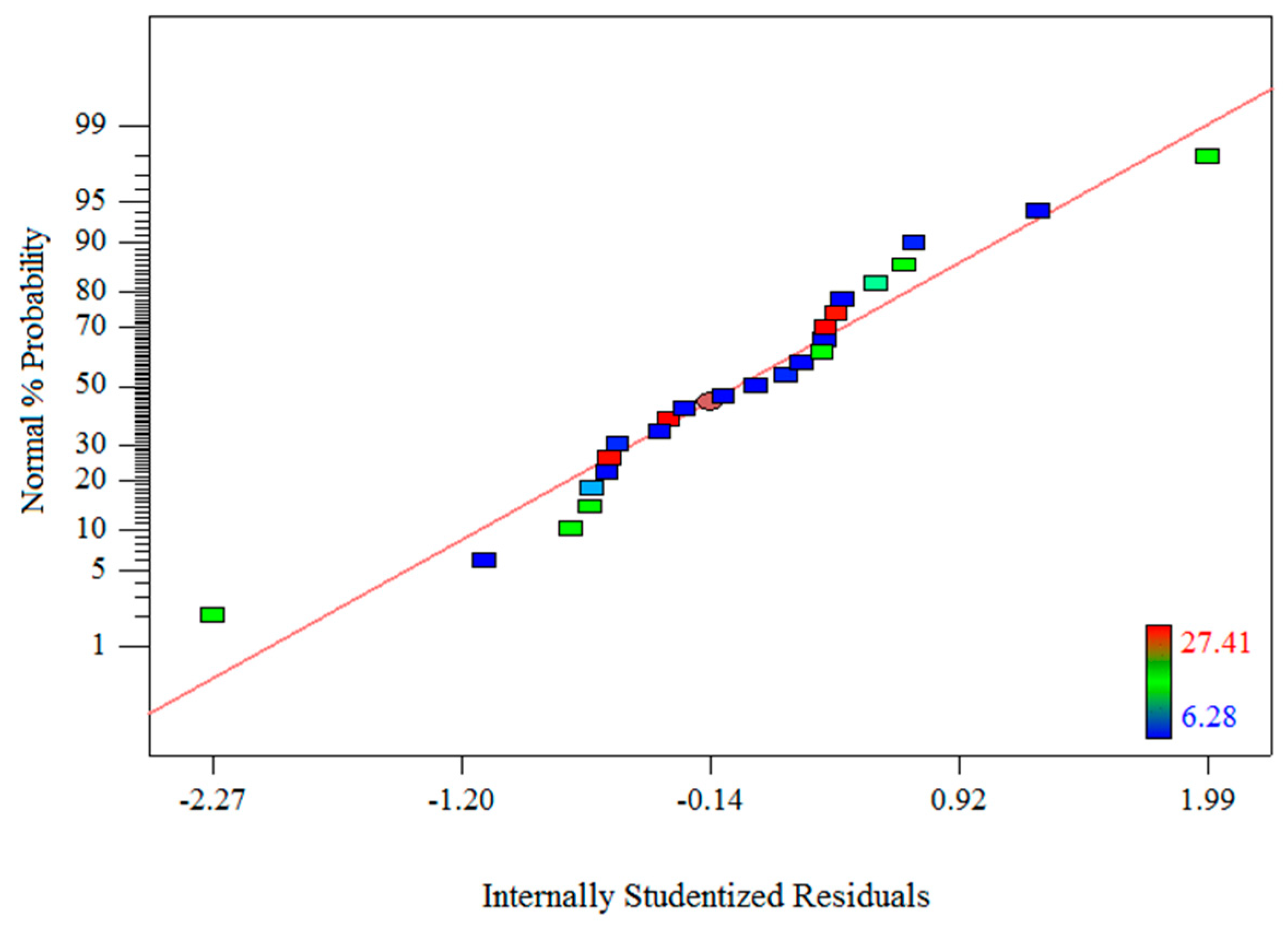

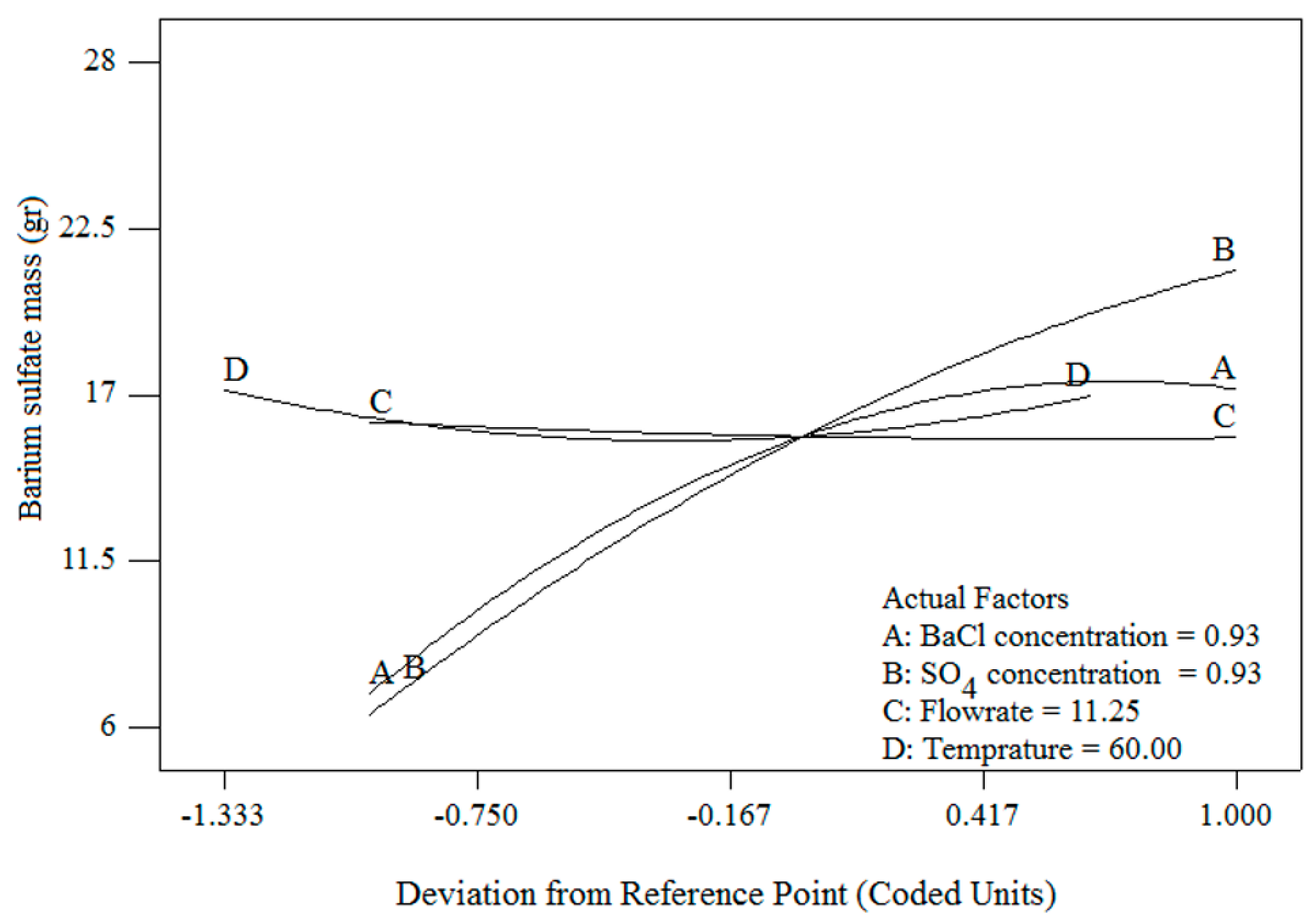
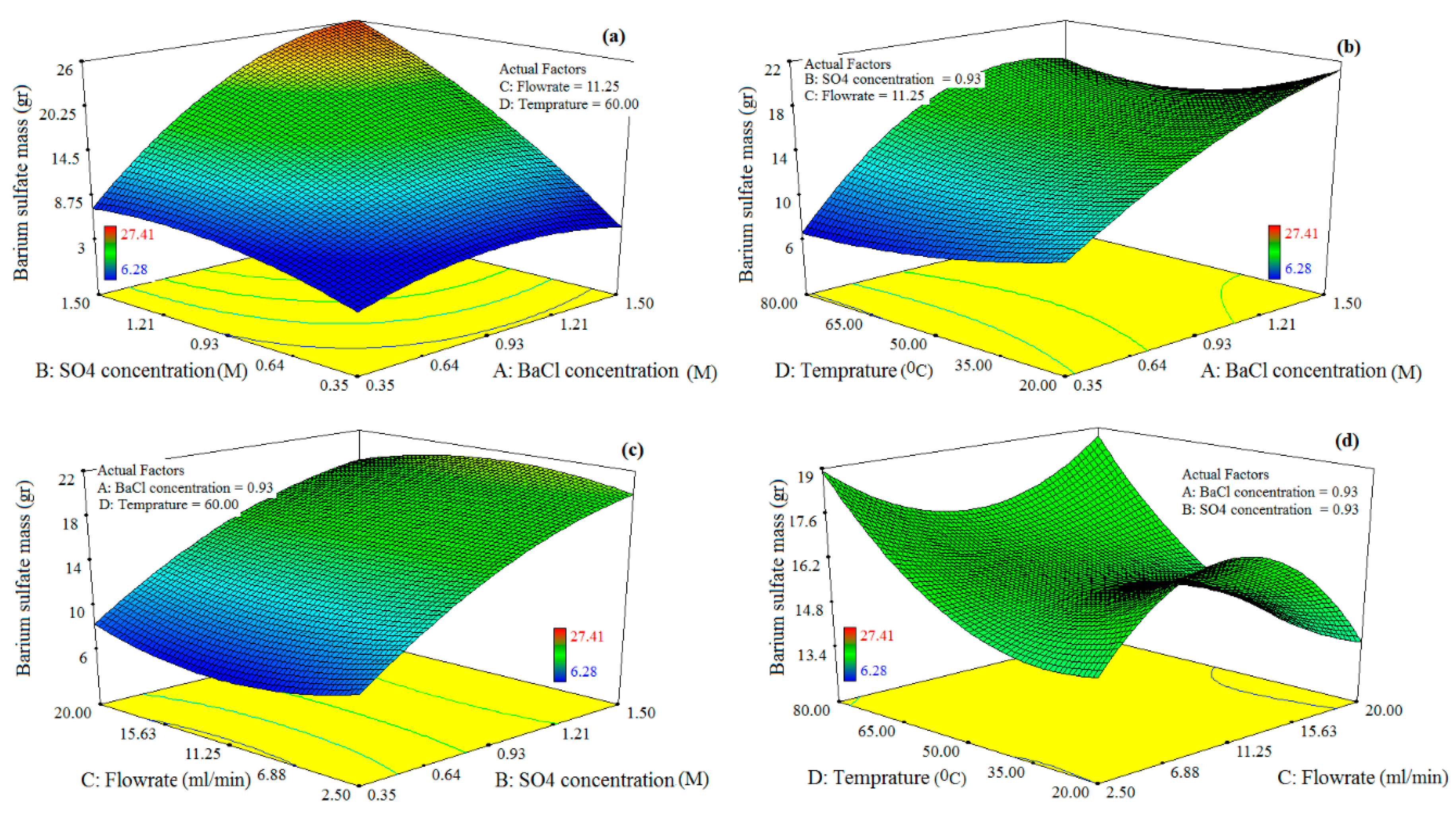
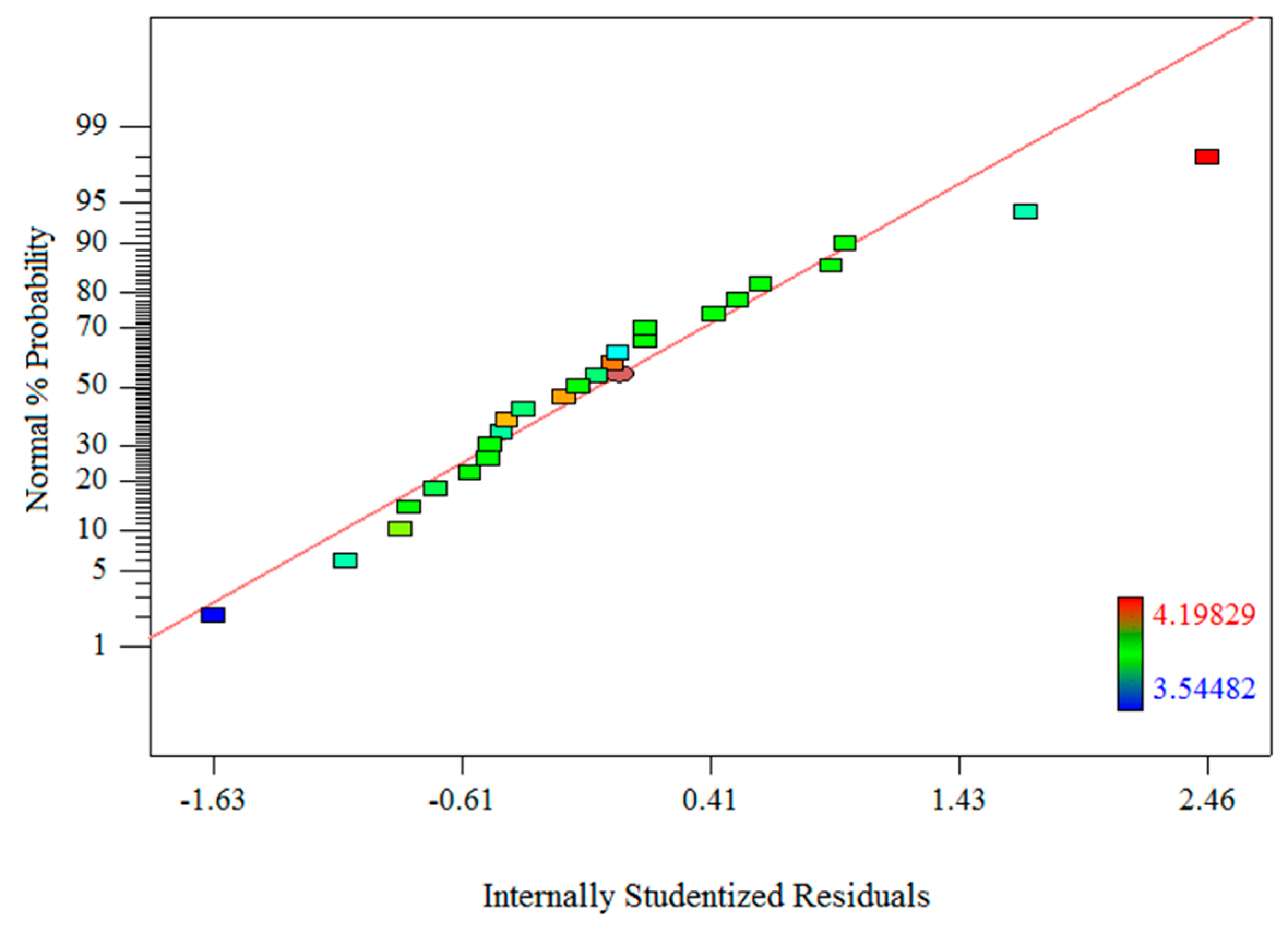

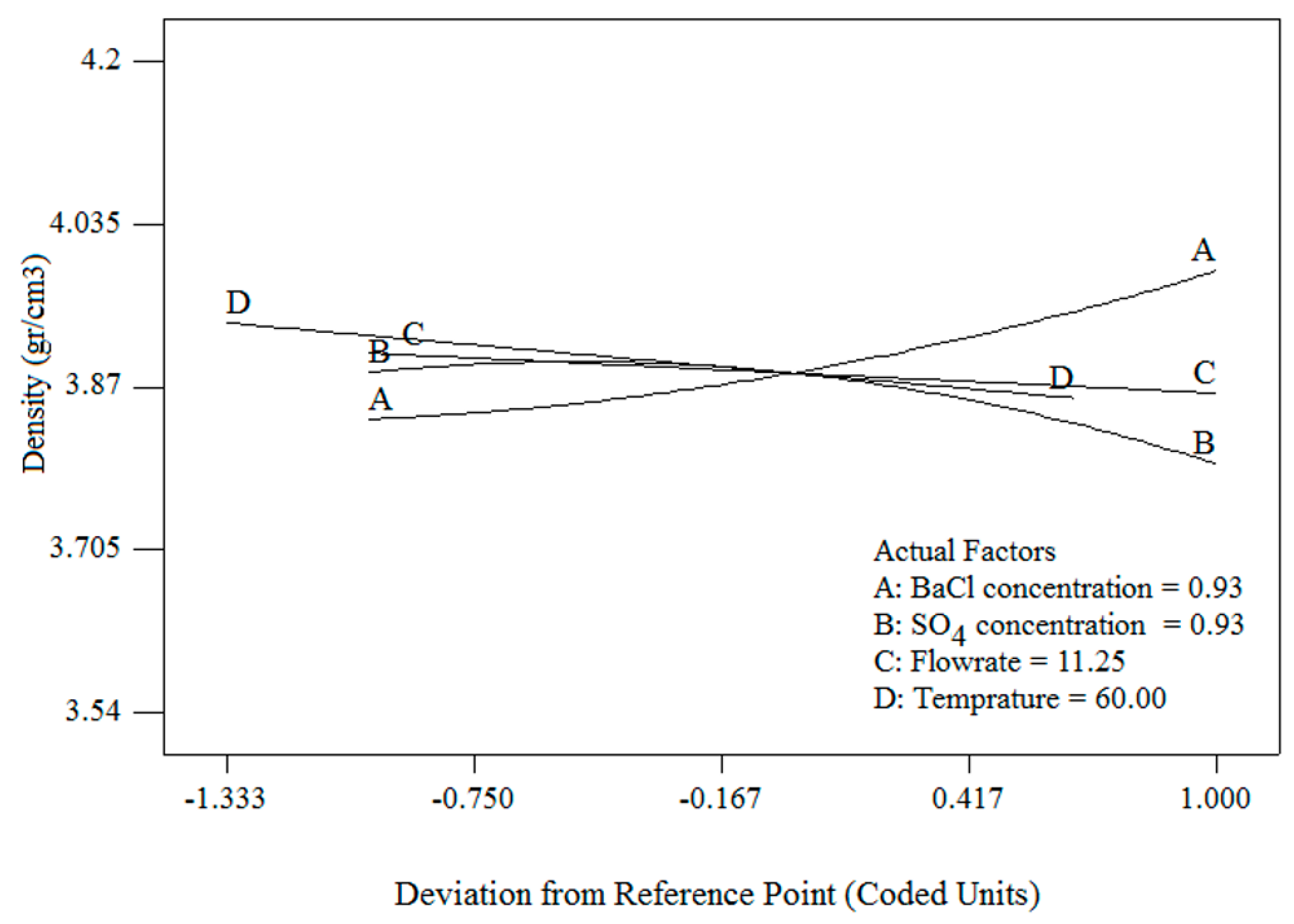
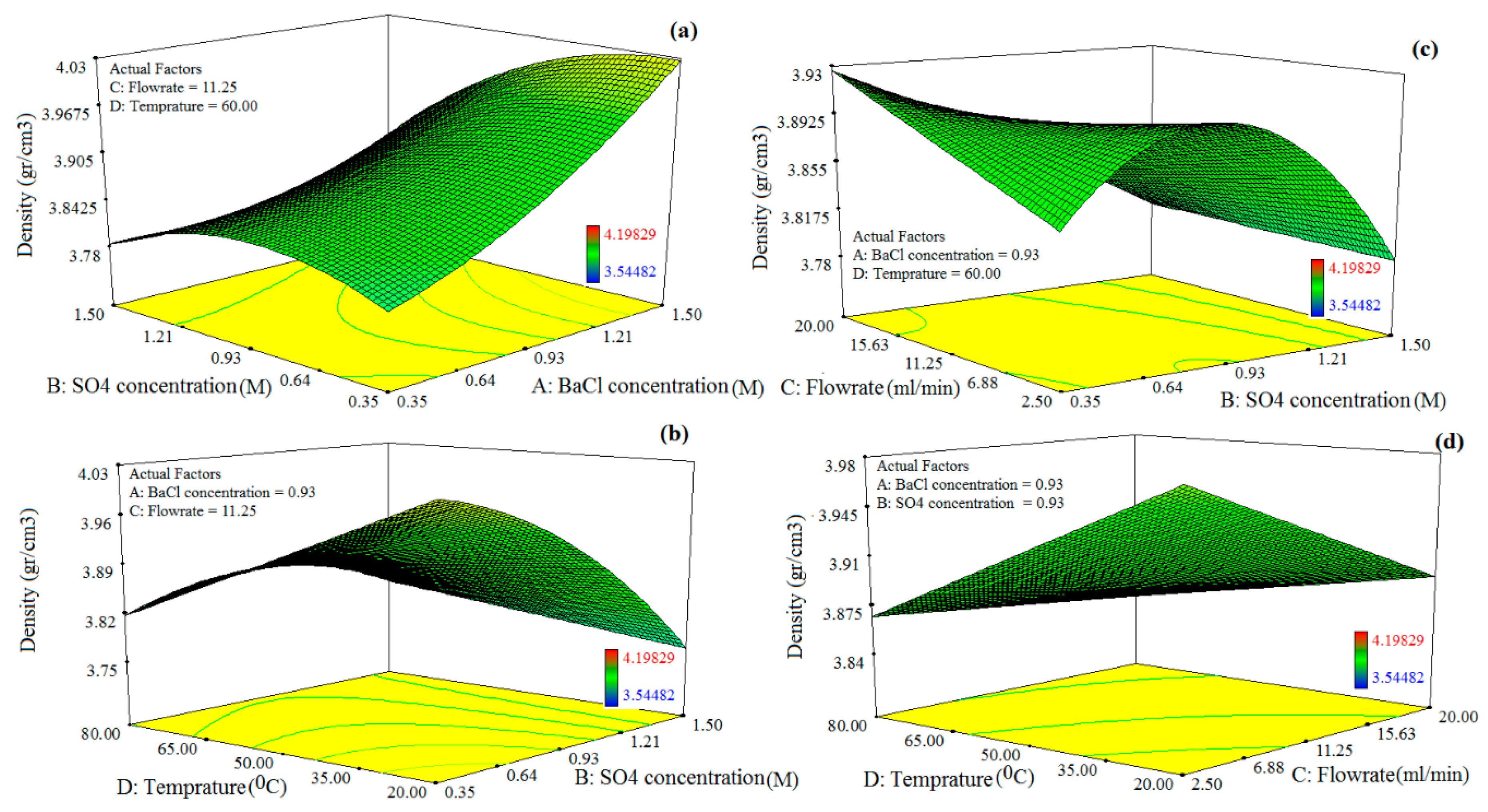
| Parameter | Type | Minimum Value | Maximum Value | Mean |
|---|---|---|---|---|
| Barium chloride concentration (mol/L) | A | 0.35 | 1.5 | 0.919 |
| Sulfate concentration (mol/L) | B | 0.35 | 1.5 | 0.904 |
| Feed rate (mL/min) | C | 2.5 | 20 | 10.617 |
| Temperature (°C) | D | 20 | 80 | 53.776 |
| Experiment No. | Barium Chloride Concentration (M) | Sodium Sulfate Concentration (M) | Flow Rate (mL/min) | Temperature (°C) |
|---|---|---|---|---|
| 1 | 1.5000 | 0.4398 | 20.00 | 72.05 |
| 2 | 0.3500 | 1.5000 | 2.50 | 20.00 |
| 3 | 1.3742 | 0.7143 | 11.51 | 46.57 |
| 4 | 0.3500 | 0.3500 | 2.50 | 80.00 |
| 5 | 0.3500 | 0.9625 | 20.00 | 42.49 |
| 6 | 1.5000 | 1.5000 | 20.00 | 80.00 |
| 7 | 1.5000 | 1.5000 | 11.24 | 39.45 |
| 8 | 1.5000 | 0.8547 | 2.50 | 20.00 |
| 9 | 1.5000 | 0.8547 | 2.50 | 20.00 |
| 10 | 0.9634 | 0.3500 | 2.50 | 42.86 |
| 11 | 0.3500 | 1.4820 | 2.50 | 71.46 |
| 12 | 0.8551 | 1.5000 | 20.00 | 20.00 |
| 13 | 1.5000 | 0.3500 | 5.58 | 80.00 |
| 14 | 1.5000 | 1.5000 | 2.50 | 80.00 |
| 15 | 0.3500 | 0.3500 | 20.00 | 80.00 |
| 16 | 0.3500 | 1.5000 | 17.32 | 80.00 |
| 17 | 0.9191 | 0.9310 | 11.21 | 80.00 |
| 18 | 1.5000 | 1.5000 | 2.50 | 80.00 |
| 19 | 0.9250 | 0.9250 | 11.25 | 20.00 |
| 20 | 0.3500 | 0.3500 | 2.50 | 80.00 |
| 21 | 1.5000 | 0.3500 | 20.00 | 20.00 |
| 22 | 0.3500 | 0.3500 | 11.23 | 20.00 |
| 23 | 0.9483 | 1.1748 | 3.59 | 47.04 |
| 24 | 0.3500 | 0.9625 | 20.00 | 42.49 |
| 25 | 0.3500 | 0.3500 | 20.00 | 80.00 |
| Model | R2 | Adjusted R2 | Standard Deviation | Mean | Adequate Precision | Coefficient of Variation (%) |
|---|---|---|---|---|---|---|
| Mass (g) | 1.00 | 0.99 | 12.86 | 12.86 | 247.33 | 0.78 |
| Density (g/cm3) | 0.82 | 0.64 | 0.083 | 3.88 | 7.80 | 2.16 |
| Source | Sum of Squares | df | Mean Square | F-Value | p-Value | |
|---|---|---|---|---|---|---|
| Model | 1449.19 | 17 | 85.25 | 8458.53 | <0.0001 | significant |
| A | 22.61 | 1 | 22.61 | 2243.47 | <0.0001 | |
| B | 22.61 | 1 | 22.61 | 2243.12 | <0.0001 | |
| C | 1.03 | 1 | 1.03 | 102.42 | <0.0001 | |
| D | 0.0200 | 1 | 0.0200 | 1.99 | 0.2013 | |
| AB | 94.39 | 1 | 94.39 | 9365.88 | <0.0001 | |
| AD | 0.1983 | 1 | 0.1983 | 19.68 | 0.0030 | |
| BC | 0.2080 | 1 | 0.2080 | 20.64 | 0.0027 | |
| CD | 0.3143 | 1 | 0.3143 | 31.18 | 0.0008 | |
| A2 | 14.87 | 1 | 14.87 | 1475.61 | <0.0001 | |
| B2 | 4.10 | 1 | 4.10 | 406.45 | <0.0001 | |
| C2 | 0.3894 | 1 | 0.3894 | 38.64 | 0.0004 | |
| D2 | 4.84 | 1 | 4.84 | 480.01 | <0.0001 | |
| A2B | 0.8433 | 1 | 0.8433 | 83.68 | <0.0001 | |
| A2D | 1.36 | 1 | 1.36 | 135.19 | <0.0001 | |
| AD2 | 0.3161 | 1 | 0.3161 | 31.37 | 0.0008 | |
| BC2 | 2.37 | 1 | 2.37 | 235.36 | <0.0001 | |
| C2D | 2.63 | 1 | 2.63 | 261.00 | <0.0001 | |
| Residual | 0.0705 | 7 | 0.0101 | |||
| Lack of Fit | 0.0055 | 2 | 0.0027 | 0.2113 | 0.8164 | not significant |
| Pure Error | 0.0650 | 5 | 0.0130 | |||
| Cor Total | 1449.26 | 24 |
| Source | Sum of Squares | df | Mean Square | F-Value | p-Value | |
|---|---|---|---|---|---|---|
| Model | 0.3864 | 12 | 0.0322 | 4.59 | 0.0066 | significant |
| A | 0.0803 | 1 | 0.0803 | 11.43 | 0.0055 | |
| B | 0.0633 | 1 | 0.0633 | 9.02 | 0.0110 | |
| C | 0.0020 | 1 | 0.0020 | 0.2837 | 0.6040 | |
| D | 0.0199 | 1 | 0.0199 | 2.83 | 0.1182 | |
| AB | 0.0172 | 1 | 0.0172 | 2.45 | 0.1431 | |
| BC | 0.0002 | 1 | 0.0002 | 0.0233 | 0.8812 | |
| BD | 0.0425 | 1 | 0.0425 | 6.06 | 0.0300 | |
| CD | 0.0026 | 1 | 0.0026 | 0.3659 | 0.5565 | |
| A2 | 0.0021 | 1 | 0.0021 | 0.2941 | 0.5975 | |
| B2 | 0.0074 | 1 | 0.0074 | 1.06 | 0.3243 | |
| BCD | 0.0143 | 1 | 0.0143 | 2.03 | 0.1793 | |
| B2C | 0.0032 | 1 | 0.0032 | 0.4532 | 0.5136 | |
| Residual | 0.0842 | 12 | 0.0070 | |||
| Lack of Fit | 0.0510 | 7 | 0.0073 | 1.09 | 0.4772 | not significant |
| Pure Error | 0.0333 | 5 | 0.0067 | |||
| Cor Total | 0.4707 | 24 |
| Test No. | Mass (g) | Density (g/cm3) |
|---|---|---|
| 1 | 9.11 | 4.29 |
| 2 | 9.27 | 4.2 |
| 3 | 9.23 | 4.26 |
| Average | 9.20 | 4.25 |
| Component | % | Component | % |
|---|---|---|---|
| Potassium Oxide (K2O) | 0.04 | Cadmium Oxide (CdO) | 0.025 |
| Sodium Oxide (Na2O) | 0.12 | Silver Oxide (Ag2O) | 0.023 |
| Iron(III)7Oxide (Fe2O3) | 0.011 | Copper Oxide (CuO) | 0.014 |
| Strontium Oxide (SrO) | 0.33 | Chlorine (Cl) | 0.93 |
| Aluminum Oxide (Al2O3) | 0.82 | Calcium Oxide (CaO) | 0.083 |
| Barium Oxide (BaO) | 62.44 | Phosphorus Pentoxide (P2O5) | 0.017 |
| Sulfur Trioxide (SO3) | 33.64 | Magnesium Oxide (MgO) | 0.027 |
Disclaimer/Publisher’s Note: The statements, opinions and data contained in all publications are solely those of the individual author(s) and contributor(s) and not of MDPI and/or the editor(s). MDPI and/or the editor(s) disclaim responsibility for any injury to people or property resulting from any ideas, methods, instructions or products referred to in the content. |
© 2025 by the authors. Licensee MDPI, Basel, Switzerland. This article is an open access article distributed under the terms and conditions of the Creative Commons Attribution (CC BY) license (https://creativecommons.org/licenses/by/4.0/).
Share and Cite
Shafiee, A.; Sadatipour, M.; Hoseinian, F.S.; Rezai, B.; Safari, M. The Optimized Synthesis of Barium Sulfate: A Scalable and Sustainable Laboratory Approach Using D-Optimal Design. Minerals 2025, 15, 621. https://doi.org/10.3390/min15060621
Shafiee A, Sadatipour M, Hoseinian FS, Rezai B, Safari M. The Optimized Synthesis of Barium Sulfate: A Scalable and Sustainable Laboratory Approach Using D-Optimal Design. Minerals. 2025; 15(6):621. https://doi.org/10.3390/min15060621
Chicago/Turabian StyleShafiee, Abdulkarim, Mohammad Sadatipour, Fatemeh Sadat Hoseinian, Bahram Rezai, and Mehdi Safari. 2025. "The Optimized Synthesis of Barium Sulfate: A Scalable and Sustainable Laboratory Approach Using D-Optimal Design" Minerals 15, no. 6: 621. https://doi.org/10.3390/min15060621
APA StyleShafiee, A., Sadatipour, M., Hoseinian, F. S., Rezai, B., & Safari, M. (2025). The Optimized Synthesis of Barium Sulfate: A Scalable and Sustainable Laboratory Approach Using D-Optimal Design. Minerals, 15(6), 621. https://doi.org/10.3390/min15060621







